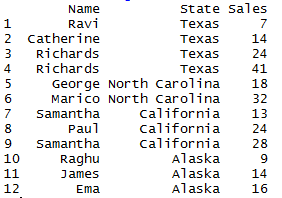
Provides a better thought out set of joins So once you’ve mastered one, you can easily pick up the othersīase functions tend to be based around vectors dplyr is based around data frames Provides a thoughtful default print() method that doesn’t automatically print pages of data to the screen (this was inspired by data table’s output).ĭplyr is much more consistent functions have the same interface. This lets you focus on what you want to achieve, not on the logistics of data storage. N_distinct(x):the number of unique values in x.įirst(x), last(x) and nth(x, n) - these work similarly to x, x, and x but give you more control over the result if the value is missing.įor example, we could use these to find the number of planes and the number of flights that go to each possible destination:Ībstracts away how your data is stored, so that you can work with data frames, data tables and remote databases using the same set of functions. N(): the number of observations in the current group There are many useful examples of such functions in base R like min(), max(), mean(), sum(), sd(), median(), and IQR(). You use summarise() with aggregate functions, which take a vector of values and return a single number. ggplot(delay, aes(dist, delay)) + geom_point( aes( size = count), alpha = 1 / 2) + geom_smooth() + scale_size_area() # Interestingly, the average delay is only slightly related to the # average distance flown by a plane. We then use ggplot2 to display the output. In the following example, we split the complete dataset into individual planes and then summarise each plane by counting the number of flights ( count = n()) and computing the average distance ( dist = mean(distance, na.rm = TRUE)) and arrival delay ( delay = mean(arr_delay, na.rm = TRUE)). Summarise() computes the summary for each group. Sample_n() and sample_frac() sample the specified number/fraction of rows in each group. They are described in detail in vignette("window-functions").


Mutate() and filter() are most useful in conjunction with window functions (like rank(), or min(x) = x). by_group = TRUE, in which case it orders first by the grouping variables Grouped arrange() is the same as ungrouped unless you set. Grouped select() is the same as ungrouped select(), except that grouping variables are always retained. When you then apply the verbs above on the resulting object they’ll be automatically applied “by group”. It breaks down a dataset into specified groups of rows. In dplyr, you do this with the group_by() function. The dplyr verbs are useful on their own, but they become even more powerful when you apply them to groups of observations within a dataset. If needed, you can weight the sample with the weight argument. Use replace = TRUE to perform a bootstrap sample. with 3,364 more rows, and 12 more variables: sched_arr_time, #> # arr_delay, carrier, flight, tailnum, #> # origin, dest, air_time, distance, hour, #> # minute, time_hour with 6 more rows, and 12 more variables: sched_arr_time, #> # arr_delay, carrier, flight, tailnum, #> # origin, dest, air_time, distance, hour, #> # minute, time_hour sample_frac(flights, 0.01) You can rename variables with select() by using named arguments:

These let you quickly match larger blocks of variables that meet some criterion.

There are a number of helper functions you can use within select(), like starts_with(), ends_with(), matches() and contains(). with 336,772 more rows, and 10 more variables: carrier, #> # flight, tailnum, origin, dest, air_time, #> # distance, hour, minute, time_hour with 336,772 more rows # Select all columns except those from year to day (inclusive) select(flights, -(year :day)) with 336,772 more rows # Select all columns between year and day (inclusive) select(flights, year :day) # Select columns by name select(flights, year, month, day)


 0 kommentar(er)
0 kommentar(er)
